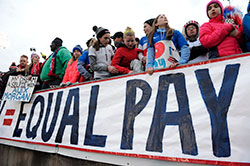Did You Know These Facts About Gender Pay Disparity?


The pay problem persists
Pay disparity between genders is a significant political issue today in the United States, and one that some will deny exists. Pay equity efforts led by non-profit organizations, along with local and state governments, have improved salaries for women over the years but a wage gap persists.
Facts & Numbers
The wage gap is often misunderstood. Everyone has heard that women make, on average, 80 cents to every dollar a man makes. What does that actually mean? It does not mean that every female worker gets paid 80% for doing the same work (although this does happen). What it means is that the average woman makes 80% what a typical male counterpart would make, not necessarily for the same jobs and not necessarily for the same number of work hours.
This Pew Research Center study can also help us put a finer point on some of those numbers. In 2015, women on the whole made 83 percent as much as men. But, women below the age of 35 made 90 percent as much as their male counterparts. This trend indicates that the wage gap is slowly disappearing. But why does it exist at all?
Causes
Pay disparity has a lot of complex causes, which can't all be fixed just by demanding equal pay for equal work; the bigger problem may be that women are boxed out of equal work to begin with. Women are vastly underrepresented in high-paying managerial positions and technical fields. Even when women work in these fields, they're more likely to be passed over for promotions and kept at lower levels of the company. This phenomenon is usually called "the glass ceiling," since it doesn't have a clear, visible cause but it stops women from climbing all the same.
Per the Pew Research Center poll, 42% of women reported incidents of workplace gender discrimination. The examples they gave can offer a bit of insight into the challenges women face in the workplace. Nearly a quarter of women reported that they were simply treated as incompetent, with others remarking similarly that they were constantly challenged or slighted, or that they weren't given the opportunity to take on more important assignments.
Many feminist scholars and women's historians attribute this to media messaging and socially-enforced gender roles that affect people growing up and into adulthood. Women in media are often presented as "more emotionally intelligent" rather that mathematically gifted, and young women are often indirectly (or directly) pressured into working in fields that utilize these soft skills. As many readers might be aware, these same positions tend to not be as well paid. Women who go into fields like computer science, for example, often face harassment from male colleagues who—due to the very male-focused environments they work and live in—assume incompetence of women or don't value them as highly as other men. These issues are present across industries, but tend to be more prevalent the more male-dominated an industry is.
These biases can also affect positions within the same line of work. High-level management and executive positions tend to go to people who are more assertive, decisive, and aggressive. The idea that women are not these things leads many to assume that women won't make good leaders if they are even considered. Some men will refuse to follow female leadership. Women are likewise culturally rebuked when they go against the expectation that they be more sensitive and nurturing. By violating this ideal of kind women, woman leaders are often called "bossy" (or other more unsavory terms).
At lower levels, companies will invest less in female employees due to an ingrained expectation that they might need to go on maternity leave (and so they're afraid to vest authority in someone who might need extended time off) or that they'll have domestic demands that take away from their work. This expectation that women will leave their jobs can become self-fulfilling, as the constant minor challenges and annoyances (without any promise of better pay or responsibilities) can drive away promising workers.
Solutions
As complex as the causes are, the solutions are even harder. Whether it's trying to change media attitudes towards women, encourage more hiring of women in STEM, or encouraging men to play an equal part in domestic issues like child-rearing (therefore removing the expectation that just female employees are affected), there's no one clear fix to the pay equity problem. Thousands of different advocacy groups are doing their small part to advance the cause of women's equality. This Women's History Month, look into initiatives and groups near you who are working towards equal pay.
By Logan Chamberlain







